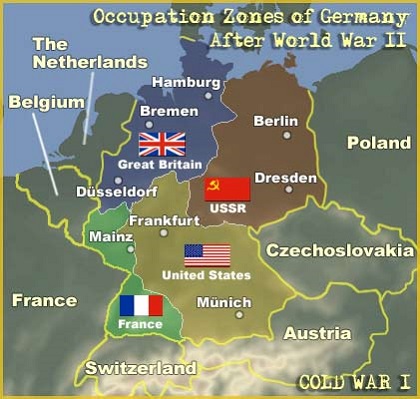
The total breakdown of civil administration throughout the country required immediate measures to ensure the rebuilding of civil authority. After deposing Admiral Karl Dönitz, Hitler’s successor as head of state, and his government, the Allies issued a unilateral declaration on June 5, 1945, that proclaimed their supreme authority over German territory, short of annexation. The Allies would govern Germany through four occupation zones, one for each of the Four Powers–the United States, Britain, France, and the Soviet Union.
The establishment of zones of occupation had been decided at a series of conferences. At the conference in Casablanca, held in January 1943, British prime minister Winston Churchill’s proposal to invade the Balkans and East-Central Europe via Greece was rejected. This decision opened the road for Soviet occupation of eastern Germany. At the Tehran Conference in late 1943, the western border of postwar Poland and the division of Germany were among the topics discussed. As a result of the conference, a commission began to work out detailed plans for the occupation and administration of Germany after the war. At the Yalta Conference in February 1945, participants decided that in addition to United States, British, and Soviet occupation zones in Germany, the French were also to have an occupation zone, carved out of the United States and British zones.
The final document of the Potsdam Conference, the Potsdam Accord, also included provisions for demilitarizing and denazifying Germany and for restructuring German political life on democratic principles. German economic unity was to be preserved.
Related articles:
The Nuremberg Trials and Denazification
Postwar Political Parties in Germany
The Creation of the Bizone
The Birth of the Federal Republic of Germany
The Birth of the German Democratic Republic
